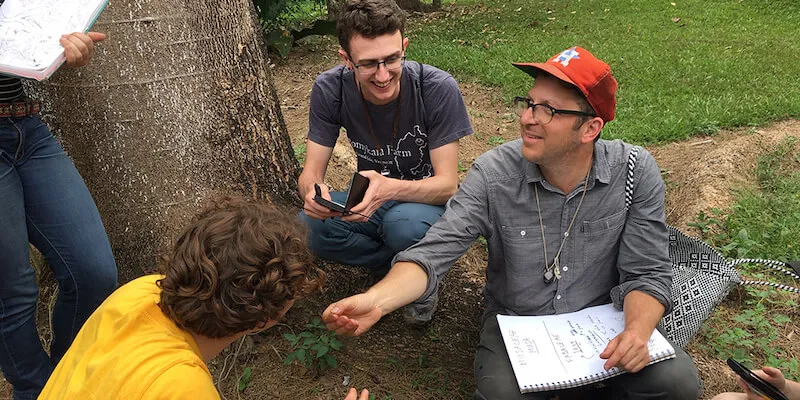For a week in March, eleven students with varied backgrounds explored the city of Oaxaca, Mexico and the nearby Sierra Juarez mountains under the guidance of plant biology assistant professor Michael Sundue.
We navigated food markets and rain forests, watched a night-blooming Psuedobombax tree burst into splendor, cooked with Zapotec women, and serendipitously stumbled upon a tiny backyard cacao and chocolate operation. Michael taught us to crush and smell leaves to help identify them, to praise delicious food with the word riquisimo, and to keep our minds open and our hand lenses ready. We learned about more than plants. “If you say ‘always,’ you’re always wrong,” Michael cautioned—a good maxim for botany, and for life.
Read on for vignettes from three undergraduate students reflecting on their experience. Photography by Melissa Pasanen, an M.S. student in the UVM Food Systems Graduate Program.
The Birthplace of Corn
By Isabella Alessandrini, a junior dietetics and food systems major
The smell of elote beckons from street corners and plazas, where vendors grill the long spears of corn to a charred bronze and then smother on mayo and fresh queso cheese. Vibrant dried cobs star in centerpieces, bejeweled with kernels of vermillion, indigo, auburn, gold. Even the husks are used to envelop tamales and to adorn church doors, curled into pale golden flowers.
The sights, smells, and tastes of corn fill my memories of Oaxaca, Mexico: the birthplace of maíz and home to 35 different land races of corn. After being nixtamalized with lime to release its nutrients, corn is transformed into its magical powdered flour form: masa harina. Masa harina thickens vegetable soups, morning mugs of hot atole, and tejate, a chilled beverage whipped to foamy, sweet bliss. Corn in all its glorious forms and flavors is braided into the history of Oaxaca and alive in the rhythms of everyday life. Read more.
Under the Radar: The Mysterious but Invaluable world of Insect-Plant Interactions
By Brianna Brianna Borch, a first-year student studying food systems and Spanish
Both the scarlet yarn woven into intricate rugs by Zapotec Women in the Vida Nueva Women’s Weaving Cooperative we visited, and many red velvet cakes have one thing in common: bugs. More specifically, pigment extracted from the cochineal, a small insect that feeds on prickly pear cacti. During a tour of the Ethnobotanical Garden of Oaxaca, we saw these cochineals, fuzzy and white from the wax they secrete, latched on to cactus pads. When you crush cochineals, the bright carminic acid which they produce as a defense mechanism bleeds bright into their white coats. Ironically, the very adaptation that cochineals acquired to protect themselves from predation has made them a precious resource to humans.
The botanical garden was also home to an abundance of old, arching trees dripping with figs. Upon opening one of the figs, we found it crawling with fig wasps. This wasn’t an infestation, but rather an intricate pollination process. Figs are a collection of flowers enclosed in a stem, which, when fertilized, turn into a collection of fruits, or an infructescence. Pregnant fig wasps enter the figs, pollinating the flowers while laying their eggs inside of the fig. These species have a mutualistic relationship: the wasps offer pollination and the figs offer a home and food source for the hatching wasps. Read more.
Rivers and Roots
By Lexi Colantuno, sophomore ecological agriculture and horticulture major with a minor in soil science
The river in Yetla runs over rocks behind the palm leaf hut creating a steady soundscape that welcomes all to relax. That river is home to small ecosystems containing long-legged birds, plants, and the water animal that became my favorite dish from all of my Oaxacan adventures: camarones. The fresh, juicy shrimp were boldly seasoned with chilies and salt. My past experiences with shrimp had not prepared me for my dive into this savory dish. With bodies soft enough to crunch right into and pull the meat from spice-soaked shells, my hands and cheeks were stained. It was by far the messiest and most satisfying dish I’ve had the pleasure of having.
Nestled between homes and rivers in valleys and on hillsides are small cultivated plots called milpas, which many families rely on for food and, at times, income. Each rich field is unique and important to the family and community. The uniqueness of place made for the uniqueness of the food, translated to the dinner tables, like the shrimp from the river in Yetla. Read more.
